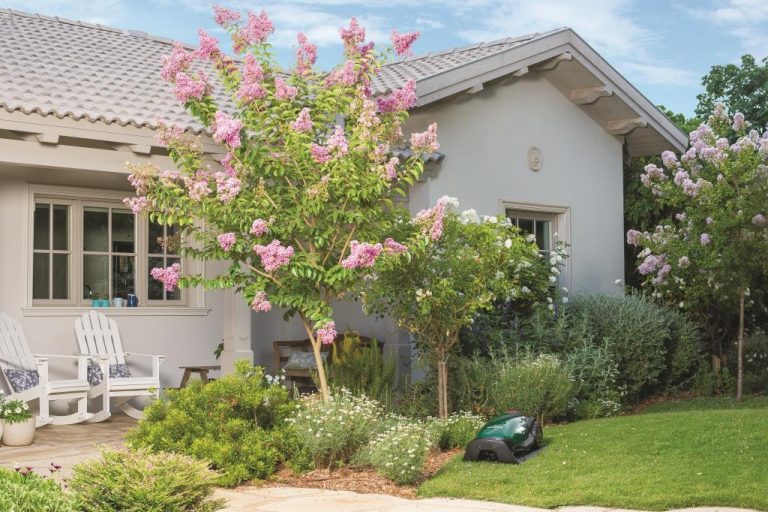Which robotic lawnmower is suitable for 3,000 m²?
14.05.2021The decision to purchase one robot lawnmower in favor of the other depends on a whole range of different criteria. After all, garden design is a highly individual matter that by no means always places the same demands on a robotic lawnmower. However, some aspects are also related to the size of the lawn. Which robot is suitable for 3,000m²?
The area output is decisive
Manufacturers usually specify both a maximum and a recommended area output. While the maximum is really only achievable under perfect cutting conditions, the recommended area output takes into account delays due to complex garden layouts, slopes or breaks in bad weather.
However, both share the fact that you need to have the robot in use virtually permanently to really achieve the output. For some models, this means a software restriction to 12 hours a day, while other models can work basically be in operation around the clock.
Usually, however, it is not the wish of a garden owner to have the robot mowing every day. In addition, night time breaks should be observed simply because of nocturnal wildlife, so as not to expose them to unnecessary danger. Moreover, breaks may be essential when children are playing on the lawn. That means the area output of the robotic mower should not be too tight.
Calculating the area output of the robotic lawnmower
Area output of the robotic lawnmower according to the manufacturer in m² x planned weekly operating times in your garden in hours / operating time in which the area output according to the manufacturer is achieved (including charging times, in hours) = actual area output of the robotic lawnmower per week.
By rearranging accordingly, you can then also use this formula to calculate how long the robot should be in use each week for a given area: existing lawn area in m² x operating time in which the area output according to the manufacturer is provided (including charging times, in hours) / area output of the robotic lawnmower according to the manufacturer in m² = required mowing time of the robotic lawnmower in hours per week.
It is also possible to calculate how large the area output of the producer must be in order to determine the existing lawn at a given mowing time:
Existing lawn area in m² / planned weekly operating time in own garden in hours x operating time in which the area output according to the manufacturer is provided (including charging times, in hours) = required area output of the robotic lawnmower according to the manufacturer in m².
High cutting width for more efficiency
The higher the cutting width of a robotic lawnmower, the more area can be mowed at one time. This affects efficiency, as the robot has to drive over the lawn less often to mow every spot. Furthermore, the battery life will be extended and the lawn will be exposed to less pressure from the tires.
Models with a cutting width of 56 cm or more are therefore particularly suitable for large gardens of 3,000 m².
Maneuverable and maneuverable
Despite that, a high cutting width should not negatively impact the mower’s ability to maneuver properly. With a practical curve function, the robotic lawnmower remains extremely maneuverable, which in turn, affects speed and efficiency.
The noise level
The quieter the robotic lawnmower moves during operation, the less you will be disturbed in your idyllic garden. Devices with a noise level of 60 or 65 dB operate as quiet as a whisper. You could theoretically even run them at night without the neighbors hearing a peep (although this is not advisable for animal welfare reasons).
Optimal grip on terrain
Large gardens of 3,000 square feet are rarely truly level. Usually, there is either a slope, hill or bump that the robot has to cope with. The steeper the terrain, the better the robotic mower must be designed to meet this challenge.
When purchasing, look for a model that is intended for slopes of up to 45% or more and have it fitted with special traction wheels. These will always provide the perfect grip, even in wet weather.
Flexible cutting heights and perfect cutting results
While the lawn grows rather quickly in the spring, longer cutting intervals are recommended during the dry phases of summer. Just before winter, the lawn should be cut low to protect it from ice and snow, while shade lawns can tolerate longer blades. The requirements for the ideal cutting height are thus varied. All the better if the robotic lawnmower is flexible enough to be prepared for the various challenges with a maximum variable cutting height between 20 and 100 mm.
Regardless of the cutting height, a pendulum-mounted mowing deck also ensures uniformly perfect cutting results even on inconsistent terrain.
Multi-zone mowing for divided lawns
If the garden has main, secondary zones or even separate lawn areas, a robotic lawnmower is needed that can control different starting points. This ensures that your entire lawn is perfectly maintained at all times and no spots are left out. An alternative to different starting points are, for example, robots that orient themselves with the help of GPS (but are also significantly more expensive to purchase).
Edge trimming reduces manual retouching
In a large garden, there are normally a lot of lawn edges. If the robotic lawnmower does not reach them completely and a few centimeters of lawn remain at the edges, manual retouching with a lawn trimmer can become a time-consuming feat.
A robotic lawnmower with an edge-cutting function, in which the blades extend beyond the wheelbase, is a perfect solution for reducing retouch work to a minimum. The prerequisite for this, however, is the careful placing of the perimeter wire, which is ideally done by an expert for a lawn area of 3,000 m².
There is an ideal robotic lawnmower for every lawn size. Upon purchasing, always consider other environmental variables in addition to the area output in order to achieve perfect cutting results.
Products
Buy a Robomow
Robomow owner
About us
Sales & Support


